
What skin can tell you about health: here are seven skin conditions spa therapists might encounter and what they could mean.
We recently wrote an article about a viral social media post, in which a nail technician allegedly spotted melanoma on a client’s nail. According to the story, previous technicians had not spotted the disease, and by the time the customer saw a doctor her prognosis was “not good.”
Signs of illness in the skin
The skin is the largest organ in the human body and can tell you much about a person’s health. And massage therapists and other spa practitioners see a lot of it.
Fortunately, massage schools train therapists in how to spot and recognize many skin conditions, but many aren’t going to remember everything. We have one story from a friend who once went to a therapist who didn’t recognize psoriasis when she saw it, of all things, and proceeded to ask pointed questions about about it and make him very uncomfortable.
This is a bad guest experience, and very unprofessional. Therapists should be able to recognize as many skin conditions as possible, and know how to act professionally should they encounter one. A service provider should never make a diagnosis, or even a guess, and if they see something out of the ordinary, they should point it out and tell the guest to visit a doctor. In the rare case that the therapist thinks a guest is potentially contagious, and feel the need to refuse that person a massage, they might tell the guest to see a doctor for their own health before seeking a massage, rather than putting the emphasis on contagion. ie: “I don’t want to cause you damage or discomfort” rather than “I don’t want to cause myself damage or discomfort.” Again, this would be a rare incident. Many skin conditions look very bad but are, in fact, quite benign. Others, however, can be indicative of serious underlying illness.
Here, for example, are seven skin conditions and what they might tell you about a guest’s health.
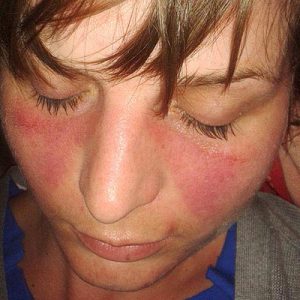 Facial rash that looks like a butterfly
Facial rash that looks like a butterfly
A malar rash, also called “butterfly rash,” appears on the face, across the cheeks and the bridge of the nose, in the shape of a butterfly. It may or may not be itchy or painful. While not technically a symptom, it is often seen in patients with lupus erythematosus, an autoimmune disease in which the immune system attacks healthy tissue in the body. The malar rash is also associated with rosacea and other health conditions.
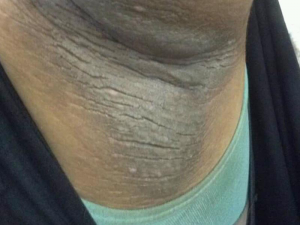 Thick, dark patches of skin in body folds
Thick, dark patches of skin in body folds
Acanthosis nigricans is a velvety hyperpigmentation in which areas of the skin appear darker than surrounding skin. It is usually found in body folds, like the neck, armpits, and groin. Acanthosis nigricans is associated with obesity, insulin resistance and hormonal disorders, like hypothyroidism and polycystic ovarian syndrome. In rare cases it may be a sign of cancer in an internal organ.
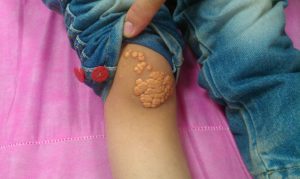 Many small yellow or pale, waxy bumps
Many small yellow or pale, waxy bumps
Eruptive xanthomatosis (EX) causes many small bumps, also known as eruptive xanthomas, to appear on the skin. They can have the appearance of a rash, are caused by elevated levels of fat or cholesterol in the blood, and are filled with fat. They may be itchy or painful. Eruptive xanthomatosis may be an indicator of several health conditions, including diabetes and high cholesterol, which can lead to other problems.
 Itch with no rash
Itch with no rash
In most cases, itchy skin (pruritis) is accompanied by a rash or irritation of some kind. A persistent itch with no visible irritation – particularly if it chronic and distracting – may be a sign of an underlying condition affecting the organs, blood, brain, or something else. Such an itch may be nothing but can be a feature of renal failure, liver disease, and, in rare cases cancers like lymphoma and leukemia.
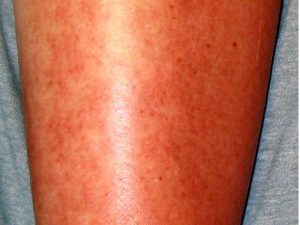 Itchy red bumps that appear suddenly
Itchy red bumps that appear suddenly
Hives, also known as Urticaria, is an outbreak of red itchy or burning bumps anywhere on the body. They vary in size from very small to quite large and are commonly caused by an allergic reaction to just about anything – food, skin products, environmental factors etc. They usually last for a few hours or about a day. Or they may be caused by illness. While they will usually disappear on their own, there is also something called “chronic urticaria,” in which hives last longer than six weeks. This may be indicative of serious illness, such as a thyroid problem.
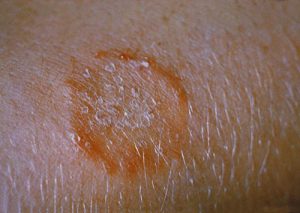 Red, itchy, circular rash with lighter skin in the middle
Red, itchy, circular rash with lighter skin in the middle
Ringworm of the body (tinea corporis) is a rash, caused by a fungal infection, that is usually circular, with a ring around the edges and a lighter spot in the centre. The rash gets its name from looking a bit like a worm and is not caused by an actual worm. Ringworm can spread through direct skin-to-skin contact with an infected person or animal, and also through contact with surfaces like towels, bedding and clothing, or yoga mats. Though not likely to cause serious complications, ringworm is contagious and the person should seek medical attention.
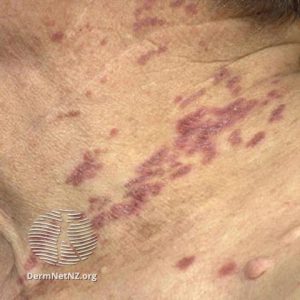 Purple lesions on the forearms, wrists, and/or ankles
Purple lesions on the forearms, wrists, and/or ankles
Lichen planus looks like purplish lesions or bumps with flat tops that spread across the skin over a period of a few weeks or months. They appear most commonly on the inner forearms, wrists or ankles, and may also appear on the genitals and in other areas. The rash is itchy and may also form blisters that burst. It’s not contagious, is unlikely to cause major complications, and will often disappear on its own. However, it can sometimes be linked to Hepatitis C.
It’s always a good idea to see a doctor if an unexplained rash appears on one’s skin. If a practitioner has concerns, speaking up may save a life.
 We’ve released our spa and wellness trends to watch for 2020. Sign up for Spa Executive’s newsletter and download the free report! CLICK HERE >>
We’ve released our spa and wellness trends to watch for 2020. Sign up for Spa Executive’s newsletter and download the free report! CLICK HERE >>
Spa Executive magazine is published by Book4Time, the world’s most innovative spa, salon, wellness, and activity management sof



